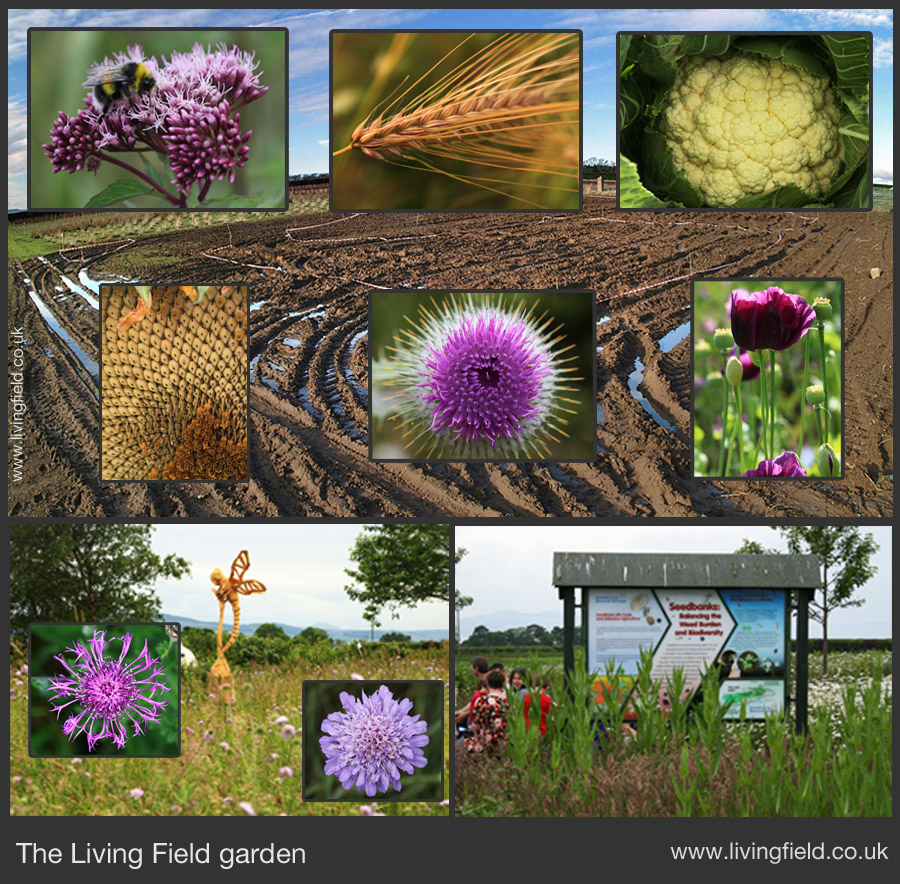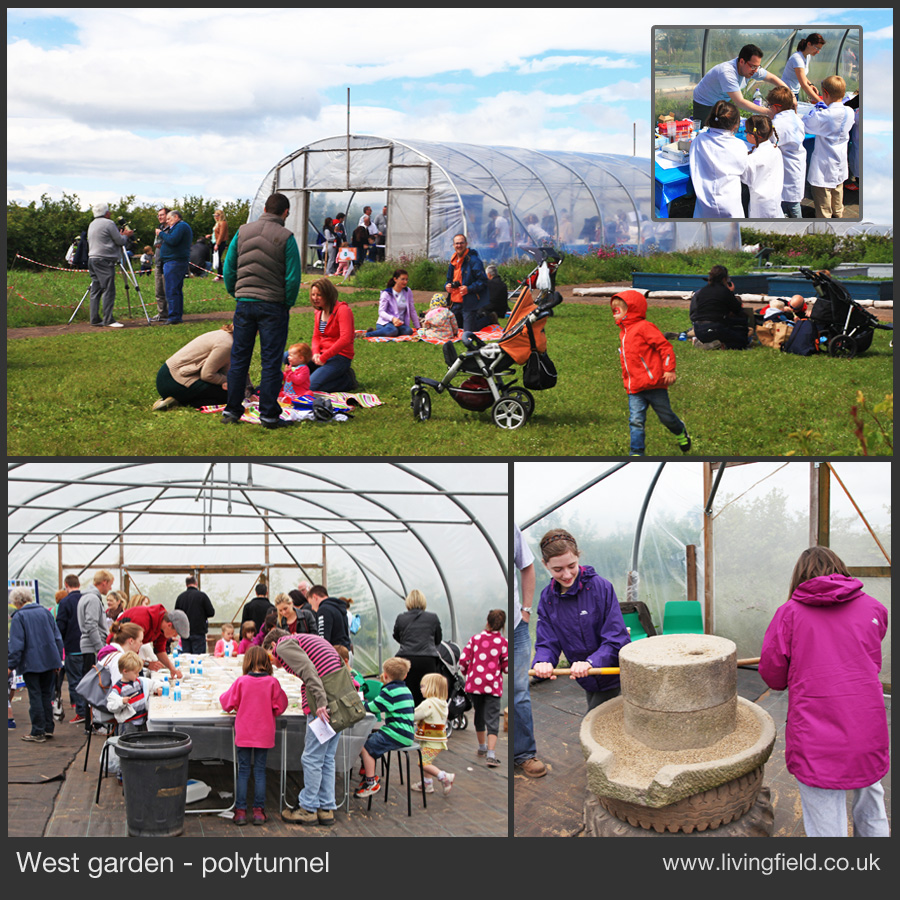Gladys Wright retired from the James Hutton Institute recently after more than 40 years of dedicated service. In addition to her field and lab work, she inspired much of the activity around the Living Field project.
She brought her knowledge of plants and cropland habitat, and with that a rare ability to draw people in, whether from the farm, her scientific colleagues or students and visitors.
Progress through the Living Field’s various projects is a story of how to get others involved and committed outside their usual line of work, to create something of rare communal benefit. It’s also a story of showing schools and the wider public the value of the science that underlies sustainable agriculture and environment. Here are some of the enduring highlights.
The Garden
The Living Field garden was more than a place to display our lowland crops and wild plants . It was a space for people to study and relax, an oasis of biological diversity, a shared venture. It began in 2004 as a muddy field, on the join between the farm and the buildings. It was mostly Gladys Wright’s concept.

Here is the original field on which are placed photos of some of the plants grown in the created habitats and cultivated plots. They are a mix of crops, such as the bere barley, cauliflower and sunflower, with medicinals and some wild species.
The two images below the field show one of the created habitats, the meadow (left) and one of the information boards designed to tell visitors about the science of cropland. After 10 years or so, the small space of the garden came to host more than 200 plant species, Many of the wild ones came in by themselves, finding a niche in which to live and reproduce.
After a few years, the garden was extended to the west, providing space to hold a polytunnel, observatory and later some raised beds used to grow vegetables and herbs.

The tunnel was a gathering place on open days, offering refuge from the rain, while the square of grass next to it was a welcoming place for visitors to rest and play. Public Open Days were always geared to the younger visitors, giving them a chance to be a scientist, a designer or even a miller. The rotary quern shown lower right in the panel was part of the Living Field’s grain-to-plate experience.
The Living Field CD
The idea of a teaching course on crops, soils, agriculture and environment arose with the formation of the garden in 2004. A large and varied team was got together from people at the Institute working in graphic design, education, public outreach, growing crops and various scientific disciplines.
The course was designed in three parts and became the Living Field CD. Copies were distributed to all schools in Scotland and it was made available online for free.

A unique point about the CD was the collaboration between people at the Institute and schools and educational professionals. Teachers offered their time to ensure the material was relevant and useable in class. The pages and illustrations of the teaching course were ‘voiced over’ by school children. The help from outside individuals and organisations was immense.
A few examples in the panel show (upper left) children and teachers at the launch of the CD, (upper right) filming by the BBC, with Jim McColl talking to some of the children involved, (lower right) a party at Radio Forth (who recorded the ‘voice overs’) and Gladys with some who contributed to the effort.
Study Centre and education
The garden’s habitats – the hedges, meadow and ditch – were all in place and growing well. Noxious weeds were tamed and some rare plants of the croplands were collected and displayed. Next in need was a place in which visitors could learn more about what they might find in the garden and surrounding farmland. Funding was gained for two portacabins, with a toilet between them, and a raised platform to connect them.
Many people from the Institute and outside were encouraged and co-opted to do their bit, to get the cabins installed and serviced with power and water.

The cabins, named the Living Field Study Centre, soon became the focal point at open days, but were used throughout the year for educational visits. There was ample space in each cabin for 10-15 visitors to sit round tables, use the computing facilities, make things with natural products, look at seeds and insects collected in the garden or use the interactive white-board (shown above, top middle).
Soon there began a series of collaborations with people outside the Institute who brought their expertise in art, craft and astronomy (among other things) to the benefit of the wider Living Field community. Our friends from the art world and Dundee Astronomical Society present exhibits or run workshops at all Open Days.

Activities were naturally extended beyond the Study Centre and garden. Many children experienced first hand the farm and its crops, its soils, bugs and beasties. The upper photos are from a visit by a secondary school to one of the fields, the insets showing a “ready, steady howk your tatties” full-on experience. The lower photos show visits by primary schools to the garden and farm.
Again, Gladys repeatedly drew in people from the farm and science groups to take part in the various demonstrations. The farm has always shown the greatest support for the Living Field, whether in creating the garden’s habitats back in 2004, offering rows of crops and field margins for study or in the monumental task of moving mountains into place for the Vegetable Map of Scotland in 2019.
Open Days
The Garden and its immediate surrounds were always a centre of activity at Institute open days. Games for the young, photographic competitions, soil pits, exhibits of old cereal landraces, of legumes, vegetables and medicinals, and ‘seek and find’ trails around special plant groups – there was something for all ages, but the approach was always to keep the primary school aged children occupied first. On LEAF Open Farm Sunday in June, the garden was mobbed.

The garden was at its best in June 2019, a busy Open Farm Sunday, when the living map of Scotland was fully formed and on display (top left in the panel). A drone image of the map and a description of how it was made are given at Vegetable map made real.
Other photos in the panel show visitors walking round the exhibits, the ‘Grow a Rainbow’ game (mid-right) matching vegetables to nutritional needs and some wild flowering plants sown to attract insects.
Open Days will be remembered as great events by both visitors and staff. They helped to form a real connection between Taysiders and the Institute.
Thanks
Gladys Wright is the last person to want or accept personal recognition, yet anyone who has worked on the Living Field project since its beginning in 2001/02 will recognise and value her central contribution to its achievements.
Looking back, it seems hard to believe that all this was done with little formal funding. Yes, there were grants for the cabins and other infrastructure [2] and the Institute for a time allocated some staff-hours from its Scottish Government funded programme. Yet the achievements were only possible through informal or voluntary effort.
It’s been a great journey. The names of the many people who have given their time and knowledge are not recorded here, but their contributions can be found throughout this web site, and on the Living Field CD. Many of those involved have retired or moved to other work, but will (we hope) retain good memories of their time on the Living Field project.
Notes
[1] The Living Field CD online is still available (though not through this current web site). However, Gladys Wright and Geoff Squire agree that it is now outdated as a guide to sustainable agriculture for schools. It is nevertheless part of the record of achievement by the Living Field community.
[2] See the About page for details of funding.
[3] For her support to Dundee Astronomical Society’s observatory in the garden, Gladys Wright was awarded in 2019 Honorary Membership ‘In recognition of outstanding assistance given to the Society over a number of years’.
